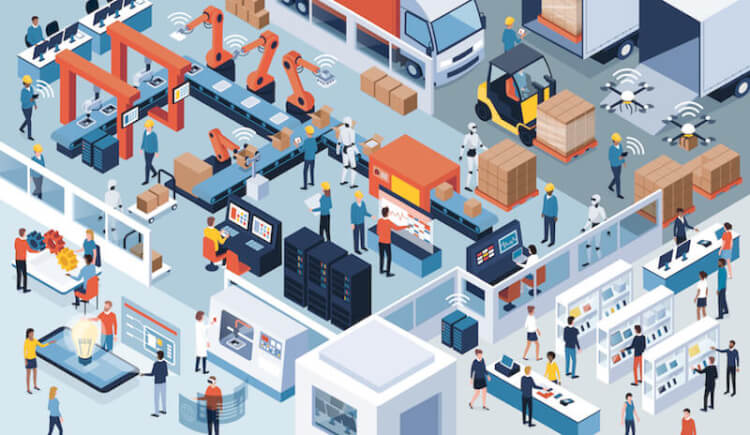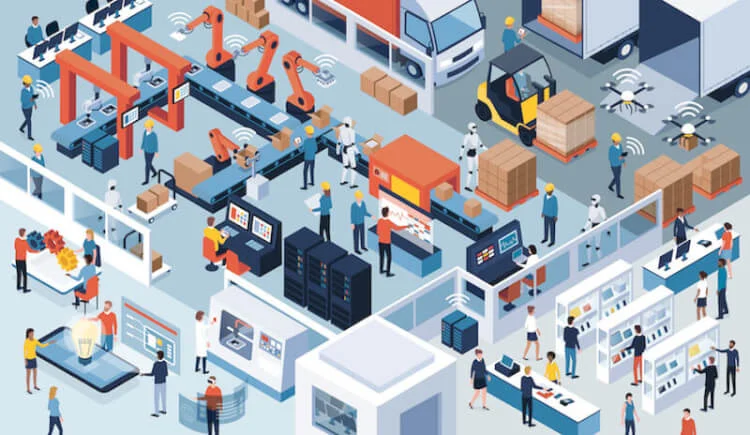
- What will the factory of the future look like?
- Evolution of AI
- IoTization
- What is smart factory?
- Microsoft’s smart factory
- Solving all manufacturing issues digitally
- Optimizing the value chain beyond the factory
- summary
What will the factory of the future look like?
Manufacturing sites are approaching a major turning point due to digital technology, and the factories of the future are expected to transform into smarter forms that make full use of digital technology. Technologies that are having a particularly significant impact on the manufacturing industry are AI (artificial intelligence) and IoT (Internet of Things). So, what exactly will the factory of the future look like?
Evolution of AI
Advances in AI are expected to move factories toward automation, efficiency, and rationalization, and to maximize the use of data. For example, AI is adept at analyzing vast amounts of data to discover trends and patterns, which can help make decisions such as detecting defective products and optimizing energy use. Since AI supports decisions and tasks traditionally performed by humans, humans will be able to devote their resources to tasks that create added value, such as management, rather than simple tasks such as inspection and assembly.
IoTization
By utilizing IoT, sensors will make it easier to visualize the operating status of production lines and machinery, allowing for optimal factory management. It is also suitable for constant monitoring and remote control, as it allows you to keep track of the factory status even from a distance. This not only makes data collection and analysis more efficient, but also enables factory operations regardless of time and place.
What is smart factory?
A smart factory is a type of factory of the future that is currently being realized. A smart factory is a factory built using technologies such as IoT. We collect and manage all kinds of data on equipment, equipment, and workers in the factory, achieving effects such as streamlining operations and improving productivity.
In Germany, the government and industry are working together to promote digitalization of the manufacturing industry as ” Industry 4.0 .” Smart factoryization is one of the important themes in that project. In addition, major IT companies and manufacturers around the world are collaborating to make factories smarter.
Microsoft’s smart factory
Microsoft is working on the development of various technologies and services to support the transformation of manufacturing into smart factories. Here we will explain the measures Microsoft is taking in the manufacturing field and the construction of its value chain .
Solving all manufacturing issues digitally
Microsoft aims to use digital technology to solve the challenges faced in manufacturing. Let’s take a look at what kind of solution you are trying to provide.
Constant monitoring of manufacturing equipment
Digital technology allows for constant monitoring of manufacturing equipment.
Equipment monitoring is a technology that is already in place in many factories and is not in itself that unusual. However, there are cases where monitoring is not working effectively because the equipment is outdated and cannot collect data, or because the data formats are disparate, making it difficult to manage.
Smart factories make it easy to collect and visualize data on manufacturing equipment. For example, sensors with IoT capabilities can be used to collect data from most devices at low cost. Additionally, by using the cloud, it is possible to centrally manage device data. Not only will monitoring operations become more efficient by making it easier to understand operating rates and operating conditions, but it will also be possible to use data to predict failures.
image recognition
At manufacturing sites, image recognition technology is useful for discovering defective products. Until now, there have been many instances in the inspection process in the manufacturing industry that have had to rely on human visual inspection. This is because products with complex structures, such as food products and precision machinery, have different shapes for each individual product and have many check items, so there is a limit to how machines can judge compliance or nonconformity.
However, if we rely solely on human visual inspection, we will have to train workers for inspections, and we will have to allocate personnel to inspections even though we are short-staffed. Additionally, since inspections are performed by humans, it is difficult to completely eliminate human error.
By using image recognition technology that is currently being developed and put into practical use, high performance can be achieved in the inspection process. Deep learning in AI allows the system to read large amounts of image data, detect specific patterns on its own, and automatically identify conforming and non-conforming products. As a result, higher accuracy and speed have been realized, and the data can be used to analyze situations where defective products are likely to occur, which will be useful for improving operations.
Remote support using VR
VR is a technology that uses video and audio that allows you to experience something as if you were actually there by simply wearing goggles or other equipment, even if you are not present at the scene. There is also a technology called mixed reality that applies VR to create multiple worlds simultaneously by combining real scenes and virtual images . If these technologies are applied in the manufacturing industry, remote support and human resource development can be made more efficient.
At manufacturing sites, work procedures and manuals are established, and there is a variety of know-how that cannot be conveyed through manuals, so it costs a lot of time for veteran employees to train workers in order to make them more proficient. However, using VR technology, it is possible to display a manual on the goggles that a new employee is wearing while working, or for a veteran employee in a remote location to instruct a new employee on work through the goggles. It will be.
In addition, even in the event of an emergency, veteran employees will be able to remotely connect with workers on the spot, giving them accurate instructions in real time and responding quickly.
Energy optimization
Digital technology can also save energy at manufacturing sites.
In smart factories, the operating status and energy consumption of manufacturing equipment can be monitored using IoT. In particular, with the development of IoT technology, not only new devices that can connect to the Internet, but also sensors for older devices that are not connected to the Internet have appeared, making it possible to collect field data at low cost. As a result, it is now possible to visualize trends such as which equipment in a factory is consuming more energy and when, making it easier to take energy-saving measures.
In addition, efficient energy use is possible for the factory’s heating and cooling functions. By installing sensors in various parts of the factory, it is possible to determine the temperature in each area, which makes it possible to distinguish between areas where heating and cooling should be strengthened and areas where heating and cooling should be strengthened. In addition, by analyzing the relationship between the location of heat-emitting equipment, the location where workers work, and the indoor temperature, you will be able to pinpoint the optimal amount of air conditioning and heating for each area.
Optimizing the value chain beyond the factory
Microsoft aims not only to improve the manufacturing environment, but also to optimize the value chain of companies. Value chain is a way of thinking that categorizes business activities according to their functions and clarifies which parts create added value and what the company’s competitive advantages and weaknesses are.
Manufacturing processes are divided into planning and development departments such as design and engineering, production departments such as factories, service departments such as customer support and after-sales follow-up, and transformation departments such as distribution and transportation. By linking data in real time, rather than treating these departments in isolation, you can determine holistically which activities are adding value.
By implementing smart factories and optimizing the value chain, you can reduce costs and increase profitability.
summary
Manufacturing sites are entering a period of transformation due to digital technologies such as AI and IoT. Smart factories, which are expected to become popular in the future, will greatly contribute to increasing productivity and efficiency in the manufacturing industry. Managers and people in charge need to understand the potential of technology and prepare for technological change.

